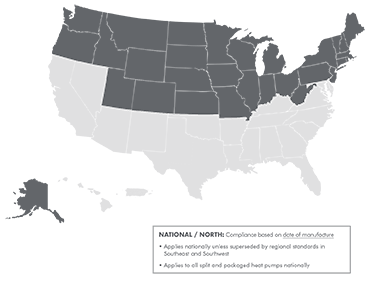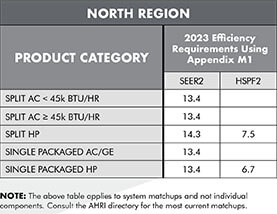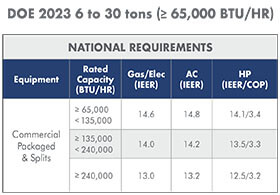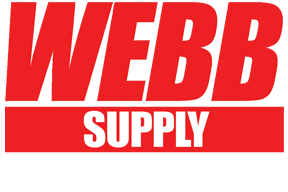
The Department Of Energy or DOE has rolled out new regulations for energy efficiency and emissions that take effect in 2023. These national regulatory changes impact the HVAC industry by making significant changes to the way efficiency requirements are calculated. Since Webb Supply is located in the North Zone, this article will focus on the changes in this region.
Minimum Efficiency Requirements
The new regulations from the U.S. Department Of Energy are aimed at reducing energy consumption and carbon emissions by establishing minimum efficiency requirements. Starting January 1st, 2023, any single-phase air conditioner or heat pump greater than <65K BTU/H will have new efficiency levels. The 2023 changes in regulation apply on a national level unless superseded by a regional standard. The regional standards only apply in the Southeast and Southwest regions, and the difference between the national and regional standards how they are enforced for compliance.
How do the DOE Efficiency Standards Impact The North Region?
The regulations were rolled out before the Inflation Reduction Act was passed. The goal of these changes is to reduce dependency on fossil fuels while increasing energy conservation standards. Due to the seasonal changes in the northern states, the regulatory requirements are a little less strict. The DOE is allowing manufacturers and distributors to sell through existing equipment inventory manufactured before 2023 without being penalized for noncompliance. When the old equipment is sold out, HVAC distributors must move to the new Appendix M1 units.

Appendix M1: A New System of Measurement
A provision in the “Energy Independence and Security Act Of 2007” established a precedent in which the DOE reviews testing procedures every seven years. This same provision from the DOE established appendix “M” which implemented a “Uniform Test Method for Measuring the Energy Consumption of Central Air Conditioners and Heat Pumps”. Appendix M also introduced the efficiency standards of SEER Ratings, EER, and HSPF. With the constant improvement in technology, this rating system quickly became outdated. in 2017 the U.S. Department Of Energy began the process to reevaluate energy savings which is what helped develop the new minimum efficiency standards presented in Appendix M1 or just “M1”.
What Changes Are Coming?
The industry standard ratings we know (SEER, EER, and HSPF) are getting a facelift. After January 1st, 2023 these ratings will be known as EER2, HSPF2, and SEER2 ratings. The metrics are changing to better reflect the field conditions of the installations in today’s homes. The new metrics will apply to all single-phase air conditioners and system heat pumps that are <65k BTU/H.
Understanding Compliance in The North Region
For The North, compliance is based on the date of manufacture. If the HVAC equipment (central air conditioner, heat pumps, furnaces, etc) was part of an AHRI-rated system match and met energy efficiency requirements on the day they were produced, the product is still considered to be compliant. Products with a manufacture date after January 1st, 2023 are subject to different efficiency ratings and new test procedures. Here’s how the new equipment must be rated.

How Does This Effect Light Commercial Applications?
Commercial single-phase air conditioners and heat pumps <65k BTU/HR (typically those in the 3-, 4- and 5-ton range) follow the residential standards. Commercial systems ≥65k BTU/HR also have new minimum efficiency levels going into effect in 2023 on a national basis, with compliance based on date of manufacture. Note that while the metrics of IEER and COP are not changing, IEER and COP minimum efficiency levels are increasing from DOE 2018 standard. EER requirements remain unchanged. See the table below for the 2023 requirements. At this time, DOE has not issued a new efficiency standard or metric that applies to the category of small 3-phase systems, 5-ton and below, but these are under consideration.

Enforcement
The DOE and environmental protection agency are set up to be aggressive in enforcing these regulations. While the North is set up in the proverbial “catbird seat” for the time being, noncompliance can result in significant penalties.
